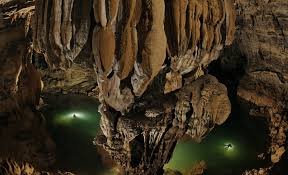Son Doong Cave is an UNESCO-recognized World Heritage Site located at Phong Nha-Ke Bang National Park, Quang Binh Province. It is also currently the world’s largest cave, and therefore a growing tourist attraction. But a recent proposal to build a cable car system inside the structure is raising opposing opinions from different sectors of the society, specifically on its impact to the natural environment of the cave.
Sun Group is the local developer assigned to the project which is proposed to be 10.6 kilometers long with four sections beginning from the entrance of Tien Son Grotto. The total time of travel is estimated to be 80 minutes from the first section to the last. It is designed to be the longest cable car in the world and has an approximated cost of U.S.$142 – 211.5 million.
But conservation experts, tourism personalities, local state officers and other sectors of the society share different views of the plan. The environmentalists are against it because it will destroy the natural and delicate state of the cave. They believe that the authors of the project are only after the financial gain and either forgot or purposely neglected its effect on nature.
The director of Exotic Vietnam Co. Truong Hoang Phuong pointed out the rolling ball effect of such a plan by stating that constructing a cable car system in Son Doong will result in additional manpower and infrastructures in order to accommodate the increasing volume of people in the area. This means having to put up as well hotels, restaurants, roads and other services to cater to new needs. This will create a long-term but serious damage to the environment of Son Doong Cave.
Tour operators of Son Doong Cave are also critical of the plan based on their experience in the business, having observed that most tourists who book the trip, especially the foreigners, intentionally take the long and expensive travel not just to see the cave but to achieve a form of self-fulfillment by enduring and conquering the day and a half and three-person support team journey (consisting of porters, cooks, guides and experts). Even the five-day, four-night program which costs a whopping $3,000 is always full because of such a mission.
Son Doong Cave tours have also increased the entry of not only domestic, but international visitors, into the province as a whole. Moreover, the length of stay of tourists has also extended from less than a day to three to four nights to visit other famous attractions like the En (Swallow) Cave, Toi (Dark) Cave, Phong Nha and the nearby coastal area. Phong Nha-Ke Bang National Park itself is also an UNESCO-recognized site in 2003 because of its impressive karst formation which could be traced back around 400 million years ago during the Palaeozoic Age. It is the most ancient in the whole of Asia. The park also boasts of 65 kilometers of beautiful caves and breathtaking underground rivers. The introduction of a cable car system might compromise this surge in tourism.
Deputy Director of the Quang Binh Department of Culture, Sports and Tourism Nguyen Van Ky has a dual take on the issue, stating that it is only fair that a World Heritage Site like Phong Nha-Ke Bang must generate economic gain for the betterment of its people and society. But alongside with this, it is imperative that the environment and cultural heritage that the site brings will be protected. Otherwise, its destruction will not only endanger the tourism of the province, but its nature and history as a whole.
But while most opinions voice out the negative impact of such a project, building a cable car in Son Doong Cave also has its benefits. In fact, a middle ground can be reached by installing the system in an identified area of the cave while keeping the rest in its natural environment. This will accommodate the different preferences of the guests while preserving the delicate condition of the landscape.
Long discussions and thorough consultations will still have to occur before such a plan will push through, if it will to begin with. The provincial government of Quang Binh will have to sit down with UNESCO; the Ministry of Culture, Sports and Tourism; and other concerned agencies to identify all points surrounding the project. While increased tourism and revenue are defining factors, protection of the natural environment and preservation of the cultural heritage of Son Doong Cave are the most important considerations in the final approval or denial of the cable car system project.
